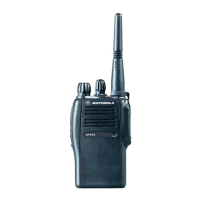1-2 THEORY OF OPERATION
The 9Z67 LDMOS driver IC contains a 2 stage amplification with a supply voltage of 7.3V.
This RF power amplifier is capable of supplying an output power of 0.3W (pin 6 and 7) with an input
signal of 2mW (3dBm) (pin16). The current drain would typically be 130mA while operating in the
frequency range of 136-174MHz.
The *PRF1507 LDMOS PA is capable of supplying an output power of 7W with an input signal of
0.3W. The current drain would typically be 1800mA while operating in the frequency range of 136-
174MHz. The power output can be varied by changing the biasing voltage.
NOTE: (*) MRF1511 LDMOS PA (Q3501) for PCB No. 8415533H02
2.1.2 Antenna Switch
The antenna switch circuit consists of two PIN diodes (D3521 and D3551), a pi network (C3531,
L3551 and C3550), and two current limiting resistors (R3571, R3572, R3573 ). In the transmit
mode, B+ at PCIC (U3502) pin 23 will go low and turn on Q3561 where a B+ bias is applied to the
antenna switch circuit to bias the diodes "on". The shunt diode (D3551) shorts out the receiver port,
and the pi network, which operates as a quarter wave transmission line, transforms the low
impedance of the shunt diode to a high impedance at the input of the harmonic filter. In the receive
mode, the diodes are both off, and hence, there exists a low attenuation path between the antenna
and receiver ports.
2.1.3 Harmonic Filter
The harmonic filter consists of C3532 to C3536, L3531 and L3532. This network forms a low-pass
filter to attenuate harmonic energy of the transmitter to specifications level. The harmonic filter
insertion loss should be less than 1.2dB.
2.1.4 Antenna Matching Network
A matching network which is made up of L3538 and C3537 is used to match the antenna's
impedance to the harmonic filter. This will optimize the performance of the transmitter and receiver
into an antenna.
2.1.5 Power Control Integrated Circuit (PCIC)
The transmitter uses the Power Control IC (PCIC), U3502 to control the power output of the radio
by maintaining the radio current drain. The current to the final stage of the power module is
supplied through R3519 (0.1ohms), which provides a voltage proportional to the current drain.
This voltage is then fedback to the Automatic Level Control (ALC) within the PCIC to keep the
whole loop stable.
The PCIC has internal digital to analog converters (DACs) which provide the reference voltage of
the control loop. The voltage level is controlled by the microprocessor through the data line of the
PCIC.
There are resistors and integrators within the PCIC, and external capacitors (C3562, C3563 and
C3565) in controlling the transmitter rising and falling time. These are necessary in reducing the
power splatter into adjacent channels.

